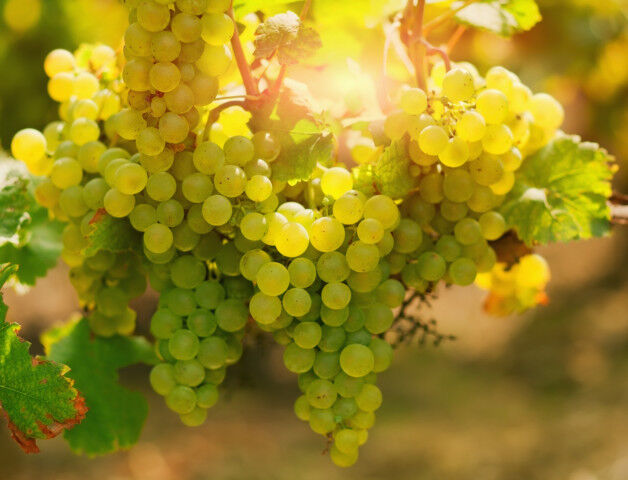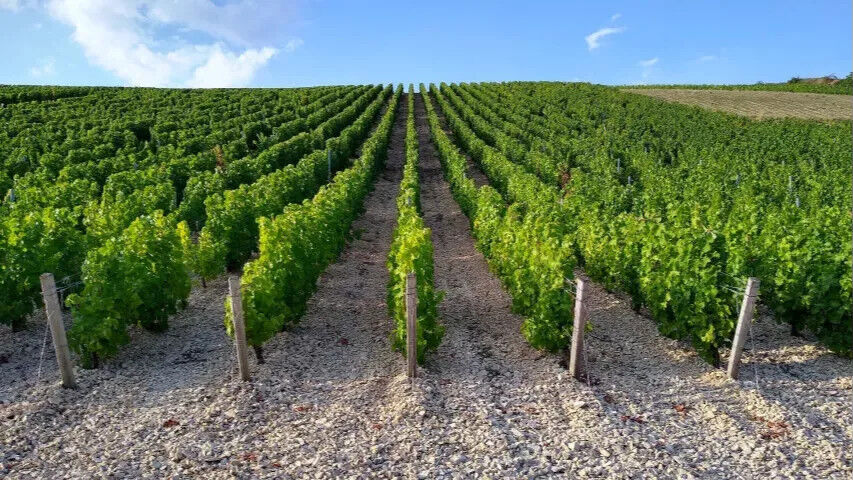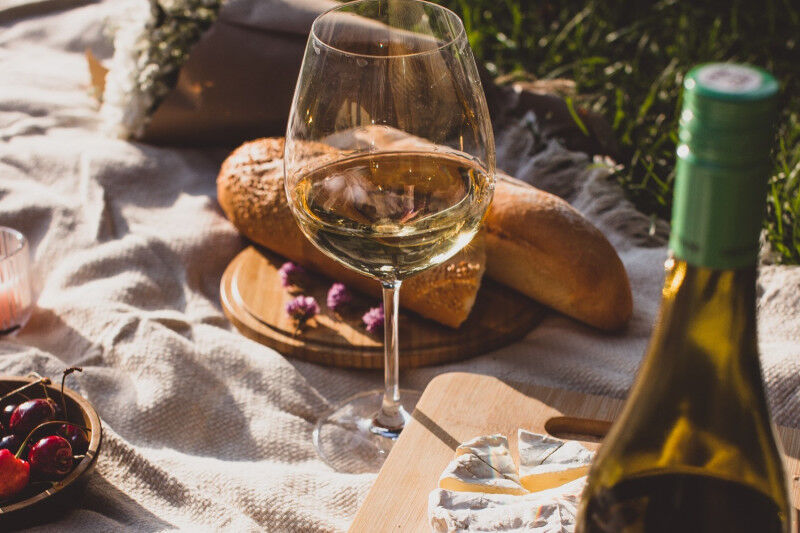Sauvignon Blanc and Chardonnay
Sauvignon Blanc and Chardonnay are both white grapes that are among the most popular around the world. That’s where the similarities end though!
Sauvignon Blanc is what’s termed an aromatic variety which means what it sounds like; it has distinct aromas and flavors that winemakers aim to protect in the winemaking process. On the other hand, Chardonnay is a non-aromatic variety. It has a fairly neutral profile and is often compared to a blank canvas because winemakers can use a host of vinification processes to craft a particular style of wine.
Naturally, for both grapes, the growing environment and its impact on the fruit also influences the final wine, but the vinification is where it’s really at – especially for Chardonnay. Another difference is they go with different foods (more on that later).
They also differ in the price point department. While you can always find a good, easy-drinking, relatively inexpensive bottle of Chardonnay, you’ll usually pay more for Sauvignon Blanc that’s at the lower end of the market.
Both are widely planted across Old and New World wine regions and make memorable wines so let’s get into the stories of these two fascinating cultivars and what to expect in a glass from Italy.
Sauvignon Blanc
It’s easy to tell from its name that Sauvignon Blanc (called Sauvignon Blanco or simply Sauvignon in Italy) is another classic French grape. Its home in France is Bordeaux in the southwest but Sancerre in the eastern end of the Loire Valley is where the benchmark wines are made.
Wine lovers often associate this grape with Marlborough in New Zealand – and rightly so. Sauvignon Blanc has found a unique environment in this antipodean country, displaying distinct aromas and flavors plus fine minerality.
Sauvignon Blanc also grows in Australia, South America, and South Africa. In California, it sometimes follows a winemaking method from Bordeaux where it undergoes oak treatment and is known as Fumé Blanc.
Closer to home in Italy, stand-out styles of Sauvignon Blanc appear in the north-eastern regions of Veneto, Alto-Adige, and Friuli-Venezia Giulia. Notably, it also grows in Emilia-Romagna, Sicily, and Tuscany as a monovarietal or part of a blend across numerous DOCs. Its balance of fruit, acidity, and body differs in different climates as does its alcohol level which clocks in at the 11.5% to 13.5% abv range.

Main characteristics of Sauvignon Blanc
- Sauvignon Blanc is pale to deep lemon.
- In cool climes it displays citrus, green bell pepper, and vegetal notes.
- In warm regions, stone and tropical fruit notes dominate.
- Sauvignon Blanc is usually dry high acidity and has a light to medium body.
- In Bordeaux, it’s blended in the sweet wine Sauternes where it adds balancing acidity.
- Usually Sauvignon Blanc is unoaked to retain fruit purity. When oaked, it features toasty notes.
- Alcohol tends to be 12.5% to 14.5%.
Examples of Sauvignon Blanc:
- Sauvignon Blanc, Meroi, 2019, Friuli-Venezia Giulia, Italy.
- Il Sauvignon Blanc, Rosa Bosco, 2019, Friuli-Venezia Giulia, Italy.
- Sauvignon Blanc, Castel Vecchio, 2020, Friuli-Venezia Giulia, Italy.
Chardonnay
Chardonnay is another iconic French grape hailing from the Burgundy region. This area remains the reference-point producer as winemakers all over the globe craft their versions of Chardonnay wines.
This cultivar is often regarded as a blank canvas grape for winemakers because it’s non-aromatic. What this means is vintners in both the vineyard and winery can experiment with a range of techniques to leave a special mark on the resulting wine.
For example, Chardonnay from the cool reaches of Chablis displays green fruit, citrus, and high acidity while the same grape in California makes full-bodied wines with ripe tropical fruit and vanilla-oak tones. Across the world, there’s just about every style in between these two. It’s also worth noting that Chardonnay is one of the grapes used in Champagne production and in many Champenois method wines around the world.
In Italy, Chardonnay is planted extensively for both mass-volume IGT wines and top-class classifications. It’s planted everywhere from the cool region of Piedmont where the Langhe DOC is found to the sweltering vineyards of Sicily. It appears in Italy’s answer to Champagne in Franciacorta from Brescia in Lombardy.
Main characteristics of Chardonnay
- Chardonnay ranges from pale to deep lemon.
- It’s one of the world’s most-planted grapes and grows in cool and hot climate regions.
- It’s a relatively neutral grape that can be molded in the vineyards and winery to produce a specific style of wine.
- It’s made in both simple and complex styles.
- The best Chardonnay has good age-ability.
- It typically has 12.5% to 14.5% abv.
Examples of Chardonnay:
- '61 Brut Wine, Berlucchi Wine Estate, Lombardy, Italy
- Chardonnay 2018, Feudo Disisa, Sicily, Italy
- Maturum Chardonnay 2018, K. Martini & Sohn, Trentino-Alto Adige/Südtirol, Italy

Sauvignon Blanc vs Chardonnay: Origin
Sauvignon Blanc
Some ampelographers think that Sauvignon Blanc is related to Savagnin a white variety from the Jura region in France. The grape has a long presence in Bordeaux but its spiritual home in France is the Loire Valley. This grape has its own offspring as well. Sauvignon Blanc partnered with Cabernet Franc produced Cabernet Sauvignon and it's similar to its famous “child” in that it’s vigorous and grows in many wine regions.
The styles of wine made from this cultivar range from the dry and acidic wines of Sancerre to the sweet blends of Sauternes where it adds acidity. can produce crisp, refreshing dry styles like in the Loire Valley as well as sweet styles seen in Sauternes and Barsac.
Chardonnay
Chardonnay comes from that nursery of grape varieties, Burgundy. Initially, it was often mixed up with Pinot Blanc, but researchers have established that Chardonnay is a cross between Pinot noir and a relatively obscure grape called Gouais Blanc.
Beyond Burgundy, Chardonnay plantings have spread rapidly and easily because it’s an easy variety to grow and vinify. Gold standard expressions hail from Burgundy with many vinification techniques copied from this region.
In New World wine-producing countries, Chardonnay is grown for high-volume and premium wines.
Sauvignon Blanc vs Chardonnay: Grapes
Sauvignon Blanc is an early-ripening aromatic grape that needs a gentle touch in the winery in order to preserve its bright fruit aromas and flavors. In some parts of Bordeaux and California, it’s oak-aged to add toasty notes and body, but this is done with care.
It flourishes in cooler climates like Sancerre where it displays citrus, green pepper, and mineral tones. In sunny areas such as New Zealand, passion fruit and stone fruit emerge.
Sauvignon Blanc grows rapidly and robustly so needs strict management in the vineyard.
This cultivar grows all over Italy, appearing in both monovarietal wines and blends. The finest examples come from Alto Adige where Sauvignon Blanc is tart and Friuli-Venezia Giulia, where riper fruits dominate the palate.
Chardonnay
This popular cultivar is resilient and adaptable. It’s an early budder so manages well the cold, continental climate of northern Burgundy but it also thrives in the warmer sites of California and South Africa.
The different climates result in a range of styles. In cool Chablis, Chardonnay is bone dry and eye-wateringly acidic while further south in Burgundy in the Macon, it’s fuller-bodied with layers of stone fruit. In hotter spots like California and Australia, Chardonnay can display tropical fruit and spicy vanilla from oak.
When grown in choice sites, this grape produces top-tier wines as well as high-volume styles from warm, fertile regions in the South of France, Chile, Australia, South Africa, Argentina, and California.
In Italy, Chardonnay appears in the traditional method bubbly Franciacorta from Lombardy. It’s also famous in Sicily where it makes rich, fruity wines!

Sauvignon Blanc vs Chardonnay: Tasting Notes
Sauvignon Blanc
In cool climes, the signature features of this grape are citrus, green fruit, high acidity, and rich minerality. In sunnier (yet still relatively cool sites), Sauvignon Blanc’s aromas and flavors develop into stone and tropical fruit still offset by high acidity and layers of minerality. When treated with oak, it boasts light toasty notes. It is generally best enjoyed young.
Chardonnay
A very versatile grape that can adapt to a range of growing conditions, Chardonnay displays citrus and green apple in the coolest spots alongside high acidity. Oak aging (where present) adds spice and toast. In hot places like California, this grape develops rich, full tropical notes and, if aged in barrel, spice and vanilla notes from American oak.
Sauvignon Blanc vs Chardonnay: Food Pairing
Sauvignon Blanc
Sauvignon Blanc is the go-to wine for vegetarian dishes, salads, and fish whether it’s in a light, acidic Loire Valley style or a complex tropical fruit Marlborough expression. For perfect food pairing, note its fruit level (light or rich), acidity, and dryness.
In terms of Italian Sauvignon Blanc, a full, fruity style from Friuli-Venezia Giulia and a light, refreshing style from Alto Adige match well with a range of dishes.
- Appetizers: Bruschetta, cured olives, prosciutto-wrapped breadsticks, hummus, crab cakes.
- Entrées: Ravioli with herby tomato sauce, grilled lamb or chicken, sushi, seafood, oysters, pesto penne, sauteed vegetables. Note that Sauvignon Blanc loves buttery sauces as its acidity cuts through the fat.
- Dessert: Fruit tarts, lemon cake, fruit pavlova.
- Cheese: Gruyère, Brie, Gouda, Goat’s Cheese, Cheddar.
Chardonnay
Depending on where it grows, Chardonnay expressions run the gamut of elegant and light-bodied (Franciacorta sparkling) to full-bodied, layered, and lush (Sicily Chardonnay). This makes it very versatile when pairing it with food. The key points to keep in mind are whether or not it’s oaked, the acidity levels, and how fruity it is.
Unoaked Chardonnay
- Appetizers: Charcuterie, seafood starters, light cheese, olives, and dips.
- Entrées: Sushi, chicken salad, seafood salad, grilled fish, green pea risotto.
- Dessert: Fruit platter.
- Cheese: Brie, Goat’s Cheese, Parmesan.
Oaked Chardonnay
- Appetizers: Creamy soup, charcuterie, seafood starters.
- Entrées: Lobster, crab, or scallops, grilled salmon, seafood risotto, creamy pasta, paella. Dessert: Fruit platter, crème brulée.
- Cheese: Brie, Gruyère, Emmental, Camembert.
Sicily Chardonnay
In addition to the foods that suit oaked Chardonnay, the rich fruit of a Sicily Chardonnay go particularly well with creamy mushroom dishes, pate, and roast game recipes.
Sparkling Chardonnay
A glass of dry Franciacorta is an ideal aperitif to warm up the palate. It’s also perfect served with tempura vegetable or fish nibbles since the acidity and bubbles complement the fat. A demi-sec Franciacorta pairs well with light creamy sweets like crème brulee so save it until last!

all.sign in to leave a review




